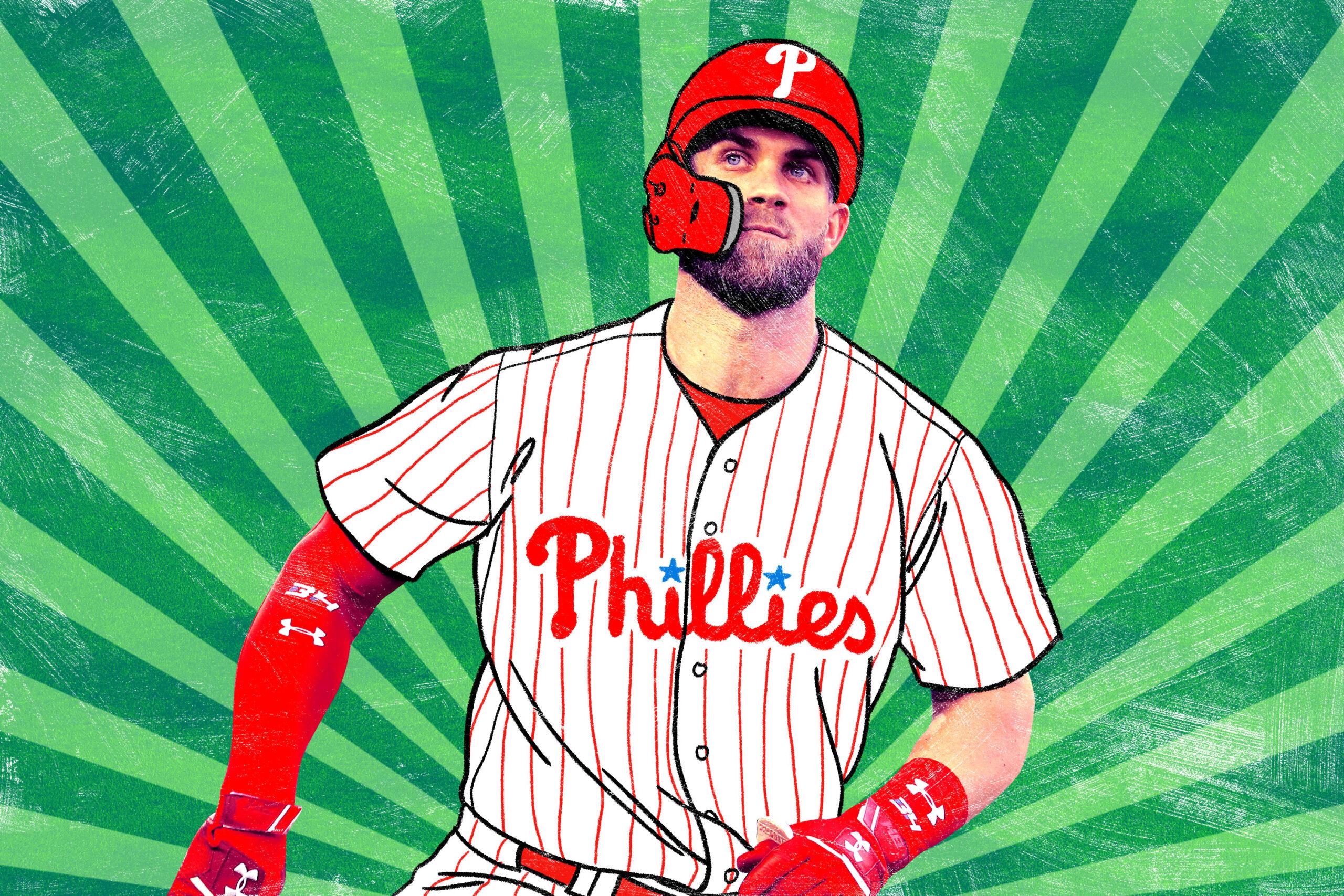With Bryce Harper in Philly, the NL East Race Just Got Really Good
Two teams in the division added three All-Stars this offseason. The team that just lost Harper could be better this year. The defending division champs are set to get a full season from a few of their young stars. One thing is clear: It won’t be fun for the Marlins.
On Thursday, the Phillies smartly spent their stupid money, reportedly signing Bryce Harper to a 13-year, $330 million deal with nary an opt-out or “swellopt” in sight and mercifully ending an offseason saga that made headlines for far too long. Notwithstanding some misleading, last-minute rumormongering about the 26-year-old star’s purported reluctance to play for a team he’s now committed to through his age-38 season, Philly had seemed like Harper’s future home since Manny Machado picked the Padres last week. Almost four months to the day that Harper hit the market—after reportedly rejecting an offer from the Nationals in the financial neighborhood of the one he eventually accepted—the Phillies made it (almost) official, ending the protracted suspense.
Although any number of teams would have benefited from adding Harper, the other two that emerged as the most active suitors in the courtship’s closing days, the Dodgers and Giants, didn’t need him as much as Philadelphia did. The Dodgers are near locks for the playoffs without Harper, and the Giants would have been long shots even with him. The Phillies, though, had to have him, in more than one way. By landing Harper, they’ve completed a commendably active offseason overhaul. And by keeping Harper within the NL East, they’ve laid the final piece of the foundation for what may be baseball’s best divisional dogfight.
Harper was a priority for the Phillies partly from a PR perspective; after owner John Middleton’s November comments about “expecting to spend money” and “maybe even be[ing] a little bit stupid about it,” Phillies fans would have been satisfied with nothing less than one of the winter’s top two free-agent prizes. But beyond the desire to save face, Harper was almost a must-have for the Phillies’ playoff push in 2019. Before the Phillies added Harper, FanGraphs’ depth-charts-powered projections put them fourth in the NL East, seven wins behind the Nationals and one win apiece behind the Mets and the Braves. Baseball Prospectus’s PECOTA projections saw things similarly, with even less distance between teams: the Nationals in first by two games over the Mets, with the Braves and Phillies four back in a virtual tie.
Considering the state of the projected standings and the upgrade that Harper represents over the Phillies’ previous presumptive third outfielder, Nick Williams, there was likely no other team in the sport that stood to benefit more from Harper’s presence than the Phillies. Absent any other major moves by the Phillies or their NL East rivals—and with the last transformative free agent off the market, it’s tough to envision one—Harper’s decision reshapes the East’s competitive picture. Harper’s potential pushes the Phillies’ projected win total above the Braves’ and Mets’ and, depending on the projection system and one’s opinion of the mercurial Harper’s true talent, closes all or most of the gap between the Phils and the now officially Harper-less Nats. (PECOTA now has the Phillies in a projected tie for first place, although FanGraphs still gives the Nats a four-game edge.)
On a dollars-per-win basis, there may have been better bargains than Harper on the free-agent market. But given the vast value of the marginal wins Harper promises, there was no better bang for the buck than the move the Phillies made. Between the tightly contested standings, Harper’s age, and a relatively low average annual value that will give the Phillies more payroll room to seek future free agents—such as Mike Trout—without paying penalties, Harper’s record contract (in total, inflation-unadjusted dollars) is a sensible spend.
Harper pushes the Phillies to the fore only because of the groundwork Matt Klentak’s team laid earlier in the offseason. Trading for J.T. Realmuto, Jean Segura, James Pazos, and José Álvarez and signing Andrew McCutchen and David Robertson wouldn’t have been a bad winter’s work for most teams. But the Phillies’ competitors pushed them to improve. Although they lost Harper, the Nationals still signed Patrick Corbin, Kurt Suzuki, Aníbal Sánchez, Brian Dozier, and Matt Adams; re-signed Jeremy Hellickson; and traded for Yan Gomes. The Mets traded for Robinson Canó, Edwin Díaz, and Keon Broxton and signed Jed Lowrie, Wilson Ramos, and Jeurys Familia. Even the comparatively quiet Braves, the defending division titlists, added a potential difference-maker in Josh Donaldson and brought back Nick Markakis. As MLB Network’s Jon Morosi noted, the Phillies imported three All-Star position players from the previous season this winter, which may be a first. But the Mets added three All-Stars too.
Almost all of the notable departures from NL East teams—Harper, Realmuto, Ramos, Sánchez, Suzuki, Jorge Alfaro—went to other NL East teams, preventing the division from leaking talent. Throw in full seasons from wunderkinds Juan Soto, Ronald Acuña Jr., and Harper’s Nationals replacement, Víctor Robles, and factor in the intrigue of Harper’s playing his former team 19 times in a pennant race, and this four-way race is going to get good. The Marlins, meanwhile, are going to get completely clobbered, which should be rubberneckable in its own, 2018 Oriolesesque way.
A month away from Opening Day, the NL East’s closest competition for the title of 2019’s most hard-fought division appears to be the NL Central, whose five clubs are all clustered within a projected range of nine to 10 wins. Although the Cubs and Pirates have been notably inactive, the Reds, Cardinals, and Brewers have been busy. Last year marked the first season since 2003 that the National League bested the American League in interleague play, and it also stood out for the dramatic difference in parity between the more evenly matched Senior Circuit and the lopsided, superteam-dominated AL. Both of those tendencies should only intensify in 2019.
The table below shows a quick-and-dirty approximation of which teams have made the most upgrades this offseason, with data provided by Dan Hirsch of Baseball-Reference. The “Gained” column represents the 2018 Baseball-Reference full-season WAR generated by the new players added this offseason (excluding free agents who re-signed). The “Lost” column represents cumulative 2018 full-season WAR produced by the players lost. “Net Gain” is the former minus the latter. For instance, the new players the Mets added this offseason totaled 16.5 WAR last season, while the players they lost combined for minus-5.5 WAR. (The non-contributions of José Reyes, Austin Jackson, Jose Lobaton, and others won’t much be missed.) That input and output yields a net gain of 22 WAR—stipulating, of course, that players won’t repeat their 2018 WAR totals, and that projected WAR would be a more accurate measure.
Biggest Net Gains in 2018 WAR, 2018-19 Offseason
The Phillies don’t rank very high here, for a few reasons. Because of Harper’s disastrous defensive runs saved total in 2018, his B-Ref WAR was only 1.3. The Phillies also lost some players who provided real value last year, including Alfaro and Carlos Santana. And because this simple method uses full-season WAR, it subtracts the entire 2018 WAR tallies of Ramos, Asdrúbal Cabrera, and Justin Bour from the Phillies’ ledger, even though those three spent most of their seasons elsewhere. Considering those caveats, the Phillies probably deserve to be bumped up a few spots. But the exact figures aren’t particularly precise or important. The takeaway from the table is that this winter’s activity was driven by NL teams making additions—particularly teams in the NL East and Central. The Twins were the only one of these net-gainers not to hail from the NL.
It’s notable, too, that none of these eight made the playoffs last year, and most finished with winning percentages right around .500 or considerably below. That’s exactly the type of team that traditionally has been the most likely to embark on an offseason addition spree. The table below shows the biggest pre-2019 one-winter net gains of the live-ball era, using the same simple method. As one would expect, most of these overhauls have happened since the advent of free agency, which made rapid player movement more feasible. The 2019 Mets figure that topped the last table would slot in second place here.
Biggest One-Winter Net Gains in Previous-Year WAR, 1920-2018
With the exception of two big-market powerhouses doubling down on their success, this list consists entirely of teams coming off so-so seasons, most of them concentrated in a band of about 90 points of winning percentage, between .438 and .531. All of those teams were good enough to dream but not so good that they could get complacent. On average, those 14 teams gained 48 points of winning percentage after their aggressive renovations. The Phillies suffered a September swoon last season that saw them sink to 80-82, so a boost of 48 points would take them to 88 wins. That would be enough to mount a late-season challenge in a division whose four best teams will be beating up on each other all summer. If the up-and-down Harper has one of his good years, though, the Phillies will be fighting for more. The 2015 NL MVP was a top-10 hitter in the second half of last season, and it’s quite possible that the awkward and possibly self-preserving outfield play on display last season will look less tentative post-payday.
Although their deliberations lasted a lot longer than anticipated, both Machado and Harper landed in logical places for amounts of money that seem roughly appropriate. Both of them joined youth-infused teams on the upswing, and both should shore up those teams’ odds of returning to the playoffs sometime soon. The resolution of Harper’s offseason odyssey, in particular, sets up a riveting race and one of the season’s most promising story lines. Plenty of less appealing players on the market this winter settled for fewer dollars or years than they sought, and some continue to wait for the right offer to materialize. But at the very top of the class, free agency functioned as it’s supposed to. It just took its sweet time.


